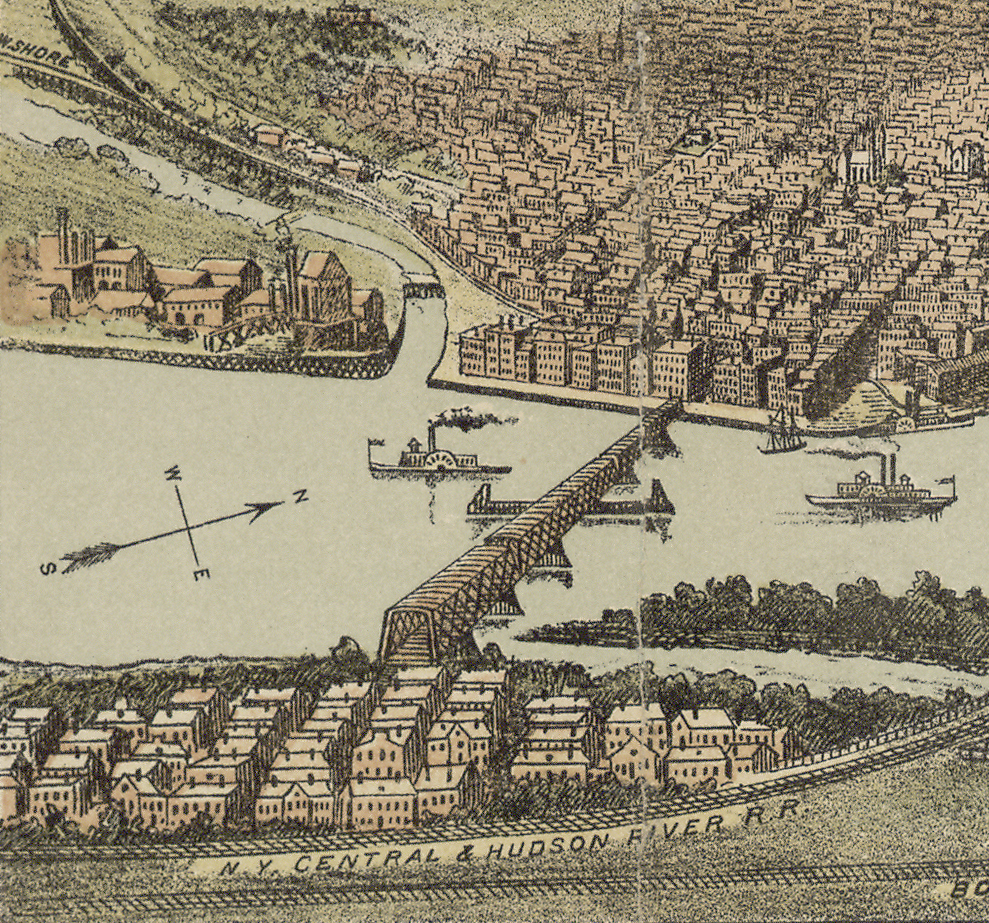
It wasn’t until after years of bickering that a bridge across the Hudson River between Albany and Greenbush (now Rensselaer) was established. The Albany and Greenbush Bridge Company was chartered by the Legislature in 1872, and immediately hit roadblocks. The merchants of Troy were dead set against a bridge, viewing it as an intentional barrier to navigation that would stop ships at Albany, to the capital city’s mercantile advantage. They’d made the same arguments against the first bridge (now the Livingston Avenue Bridge) and the Maiden Lane bridge, both built in the years after the Civil War. The ferry lobby wasn’t too keen on it, either; having lost the fight against the railroad bridges some twenty years earlier (and with it, a lucrative business moving rail cars across the river), the ferry operators realized that a crossing that would accommodate people and horses would probably be the end of the business.
Somehow the public interest prevailed, and on Jan. 24, 1882 the first Greenbush Bridge opened. We haven’t previously stumbled across any images of that first bridge after it was built, so we’re thrilled to find this lovely engraving from an 1886 Albany Bicentennial commemorative history. The bridge was a swing bridge, similar to the Livingston Avenue Bridge.
On the Albany side, you can see the mouth of the Island Creek, a northern extension of the Normanskill (dammed or bridged, it is not clear). The land between it and the Hudson is Westerlo Island, owned by the Van Rensselaer Land Co. The railroad running just north of the creek is the Delaware and Hudson Canal Company Rail Road; the West Shore Rail Road connected just outside this picture. On the Greenbush side, the tracks of the New York Central and Hudson River Rail Road are heading toward the Maiden Lane Bridge, and the Boston and Albany is heading on up north.
According to an article in the Albany Evening News on the occasion of the opening of the new Dunn Memorial Bridge, the Greenbush bridge opened on Jan. 24, 1882, and was designed for both highway and railroad use, but the upper portion for railroad tracks had never been completed.
It was built on speculation by Jose N. Navarro, builder of the first elevated road in New York City. Navarro had an idea he could unload the span on one of the railroads, but his principal prospect, the New York, New Haven and Hartford failed to grasp “the opportunity” and Navarro’s completed project slipped into the hands of New York bankers.
Subsequently the bridge company, headed by A. Bleecker Banks, a former mayor of Albany, operated the span as a toll bridge for the bankers. Years later the bridge was sold to the old Albany Southern Railway and by that company to the state of New York in 1919. It was then made a free bridge.
The Roof Garden
There was one odd feature to the Albany-Greenbush bridge, at least for a brief time. According to a column in the Times-Union back in 1928,
Some thirty or more years ago a roof garden was maintained on the Albany and Greenbush bridge. It was in existence for one season and then discontinued. The garden was located on a platform erected high on the draw of the bridge which draw is one of the longest in the country. There music and light refreshments were to be had and the garden proved a most popular place, especially during the very warm weather. The high location with the Hudson river flowing beneath and the draw opening and closing at intervals during the evening, made the time spent there most delightful and refreshing.
The roof garden was spacious and was prettily decorated with varied colored lanterns which not only provided light for the garden, but constituted a picturesque sight high in air over the middle of the river. At the time there were seats along the side walks of the bridge and people came in large numbers to enjoy the cool air both on the walks of the bridge and in the roof garden.
Of this roof garden, we find not another mention anywhere.
Numbered Days

The Greenbush Bridge stood until it was replaced by the new Dunn Memorial Bridge, which opened in 1933. The old bridge was intended to be demolished within 90 days of the opening of the Dunn, but dating on this photograph seems to indicate it lasted some time longer than that.

Leave a Reply